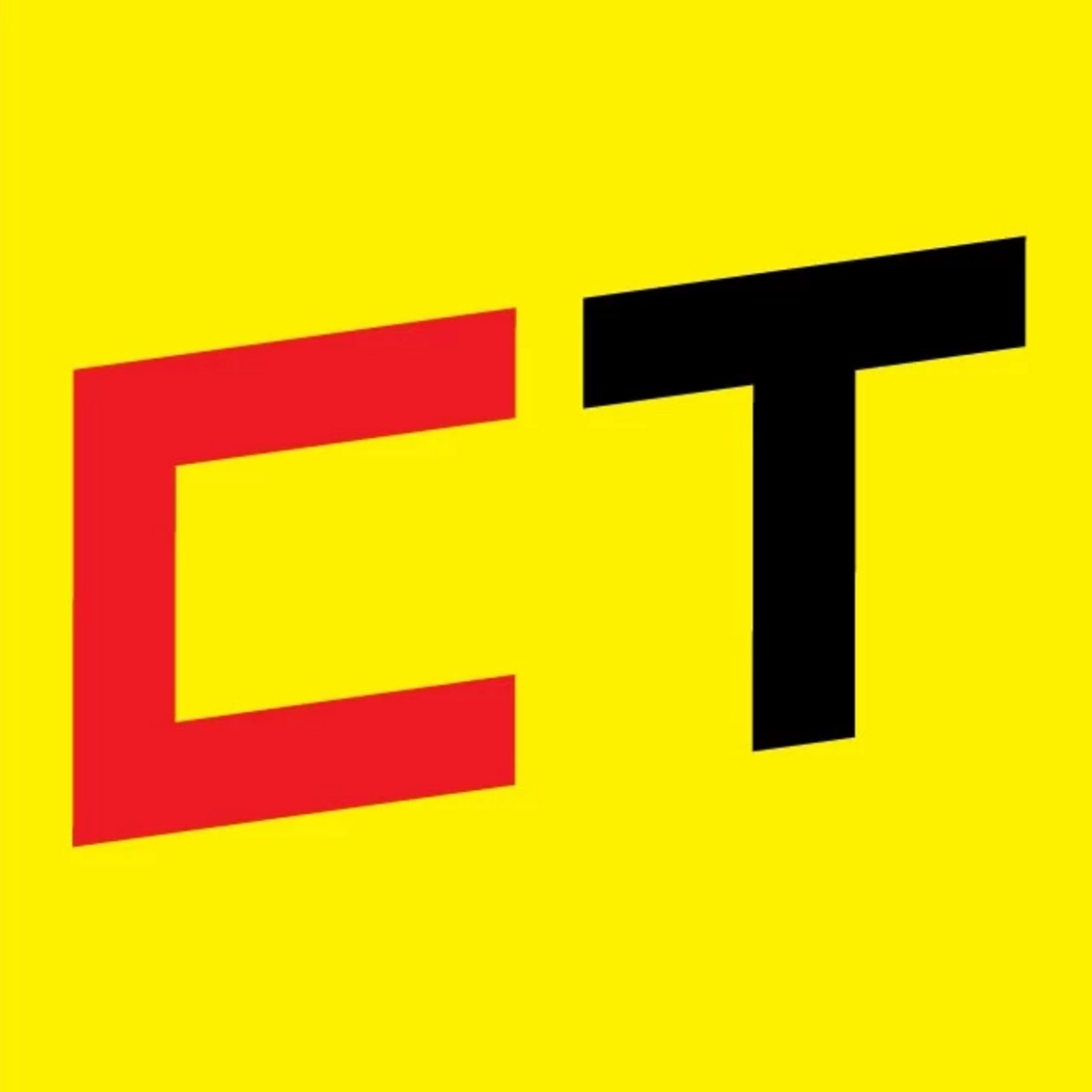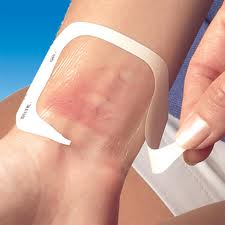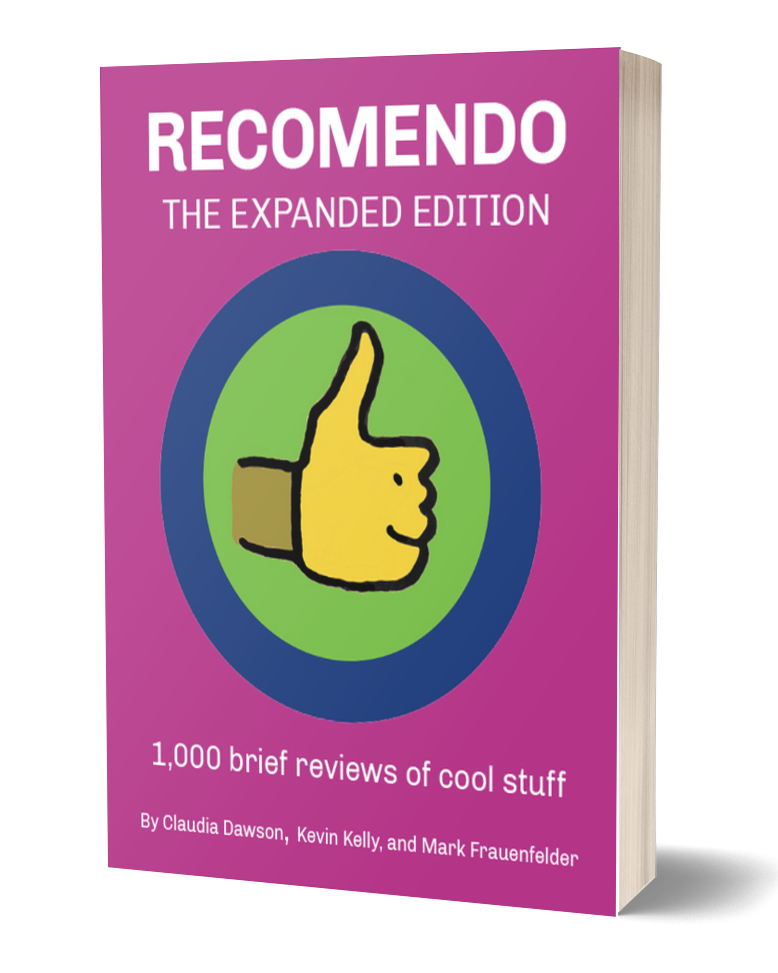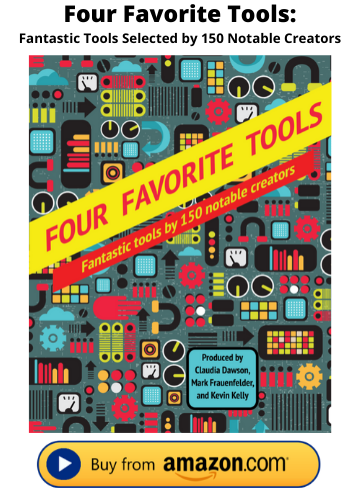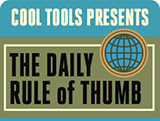04 January 2026
KK / Flat phone grip / Is it a cult?
Recomendo - issue #495
Trendy newsletter
I, too, now have a Substack newsletter where I post a short essay once a week. It’s my “works in progress” on technology, culture, travel, art, and even spiritual stuff. Some of my essays are brand new, and some are older pieces cross-posted from my Technium blog. Instead of having to visit the blog, I send it to you in an email (that is Substack). My pieces are low-stakes, cold takes – I am not in a hurry. I aim to pay attention to long-term trends. Comments are active and I try to respond to sincere comments. Sign up at KK on Substack. It’s free (although I have some paid subscribers, thank you!). — KK
Flat phone grip
My wife replaced her PopSocket phone grip to the new Snap Grip 5 ($40). It’s just 3mm thick, with a profile that prevents it snagging on pockets like bulkier grips. It has a powerful magnet that snaps to MagSafe phones. You can use it as a one or two-finger grip, flip it into a sturdy kickstand, or stick your phone to any metal surface (fridge, gym equipment, car door). Works with iPhones and includes an adapter for Android phones. — MF
Is it a cult? Assessment Tool
My mother is a seeker, so I grew up baptized multiple times and in and out of various churches. As an adult, I’ve had to rebuild my relationship with both spirituality and community, and I tend to assume every organized group with a shared mission is a cult until proven otherwise. That’s why I really appreciate this carefully constructed “Is It a Cult?” tool by ClearerThinking. The assessment looks at things like unusualness, conformity, isolation, control of information, ethics, and sacrifice, reflecting the nuanced criteria behind their Cult Assessment tool. ClearerThinking’s programs and assessments are grounded in empirical data and are balanced in perspective, and this particular questionnaire understands that being a cult is not binary—it’s a set of traits, each of which lies on a continuum. — CD
Air Fryer Convert
I was skeptical about air fryers until I tried the Ninja Crispi. It comes with three glass containers so you can see your food cooking, and they’re non-toxic (no Teflon coatings). I’ve made sweet potatoes that came out caramelized on the outside and soft inside. It’s perfect for crisping frozen samosas and pupusas in minutes. My mother baked a whole chicken in it beautifully. The containers go from freezer to cooking to table to dishwasher. — MF
Reclaiming five-to-nine
This piece argues that most nine-to-five workers underuse their after-work hours because we stay in our “inner CEO” identity, which hijacks free time with urgency traps like emails, Slack pings, and low-value work that keeps laptops open all night. The advice is to acknowledge and give time to our other inner characters—like the Lover, Artist, Friend, and Athlete—and create a simple cast schedule for weeknights. For example, on Mondays the Athlete moves your body, on Tuesday the Friend schedules a conversation or hangout, and so on. The real key is honoring the end-of-work transition with a shutdown ritual: create a two-do list for the next day, close unnecessary tabs, say out loud “Workday closed, artist open,” and then do something sensory (shower, stretch, short walk, or after-work-only music) to let the next character take the spotlight. — CD
Advice guru
My favorite advice guru is Dan Pink. He is very wise, but also very concise. He can convey a book’s worth of advice in a few minutes – and his advice is good and practical. He is a master of dispensing his wisdom in very short videos. His latest class is a 4-minute lesson on How to Fix Your Attention Span. Might as well stay for his other lessons as well. — KK
Sign up here to get Recomendo a week early in your inbox.
01/4/2601 January 2026
Best Retiree Spots/Welcoming Nomad Destinations/Loyalty Doesn’t Pay
Nomadico issue #186
Sunny Places to Retire
While Mexico is the most popular retiree destination for Americans and Canadians by a huge margin, it’s #5 on the annual Global Retirement Index that International Living produces. The top spot usually goes to Panama, thanks to its generous perks and terrific medical care, but this year it got edged out by Greece, which offers a residency permit to those spending at least 250,000 euros on real estate. Unlike Panama and number two Costa Rica, Greece offers plenty of variety in climate, altitude, and places to get away from the crowds. Other countries in the top-10 are Portugal, Italy, France, Spain, Thailand, and Malaysia.
Welcoming Countries for Nomads
If you’re not ready to put down roots but want to spend quality time where you land, only some of the countries that are great for retirees are also great for digital nomads. Thailand, Costa Rica, and Mexico are three of the exceptions in terms of countries where you can spend six months or more at a time without getting formal, long-term residency. Plenty of countries offer some kind of digital nomad visa, but a lot of those come with onerous requirements and tax obligations on foreign income. See my rundown here of the most welcoming countries for nomads and remote workers.
Airline Loyalty Doesn’t Pay Off for Most Travelers
American Airlines says that passengers buying their “basic economy” tickets (their match to Spirit or Ryanair service) will no longer earn loyalty points on their flights. Sadly, other legacy airlines will probably follow suit. This proves once again that high-spending frequent business travelers with elite status are now the only ones who earn significant frequent flier points from actually flying. (One example of how bad the payoff is: a business class flight from Mexico City to Tampa on Delta will earn me a whopping 1,000 SkyPesos.) Forget loyalty: if you want to earn free flights, you’ll get there far faster by just maximizing your credit card spending instead, preferably with a card that allows multi-airline transfers, like Sapphire Preferred.
Another Points Currency with Rove
Apart from the Chase points mentioned above and others available via Amex and Capital One, here’s a lesser-known option that could pay off even faster, especially if you like to stay in independent boutique hotels instead of chains. If you book through Rove Miles instead of, say, Expedia, you can earn 5 to 25 points per dollar that you can then cash in or transfer out. Flight bookings earn the lowest, but you often see 10 to 25 points per dollar spent on hotel bookings, on top of whatever your credit card is giving you. Plus they have a shopping portal. Then if you want to transfer points out, they connect to airlines in all three airline alliances: Star Alliance, One World, and SkyTeam.
A weekly newsletter with four quick bites, edited by Tim Leffel, author of A Better Life for Half the Price and The World’s Cheapest Destinations. See past editions here, where your like-minded friends can subscribe and join you.
01/1/2630 December 2025
Mann’s Pictorial Dictionary / Death is Stupid
Issue No. 98
MANN’S PICTORIAL DICTIONARY AND CYCLOPEDIA – THE MOST MISCELLANEOUS MISCELLANY OUT THERE
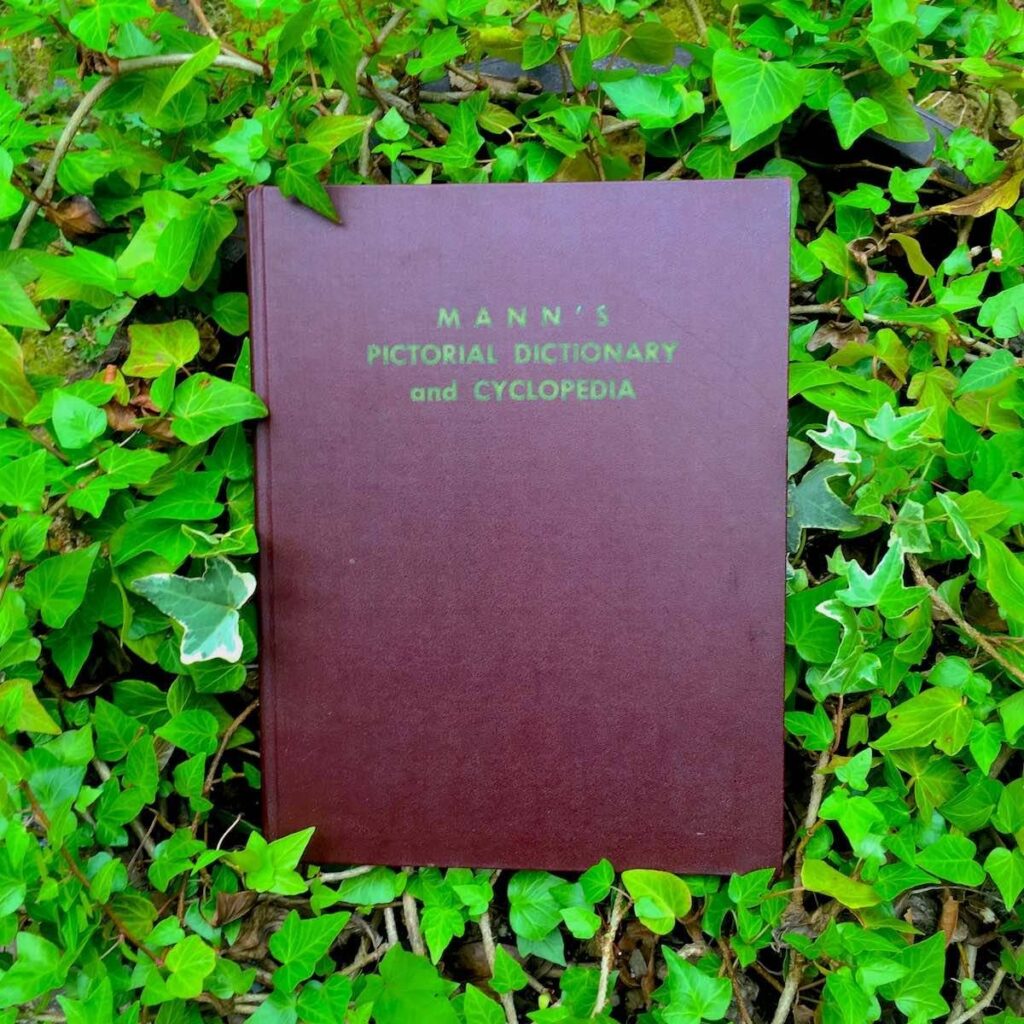
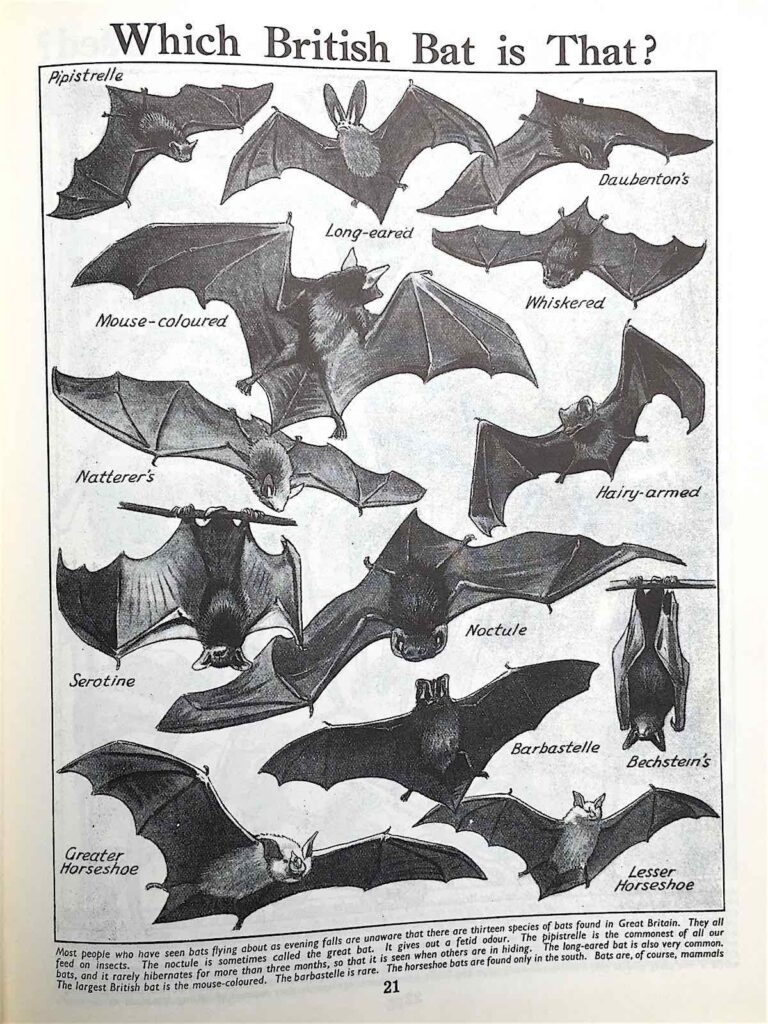
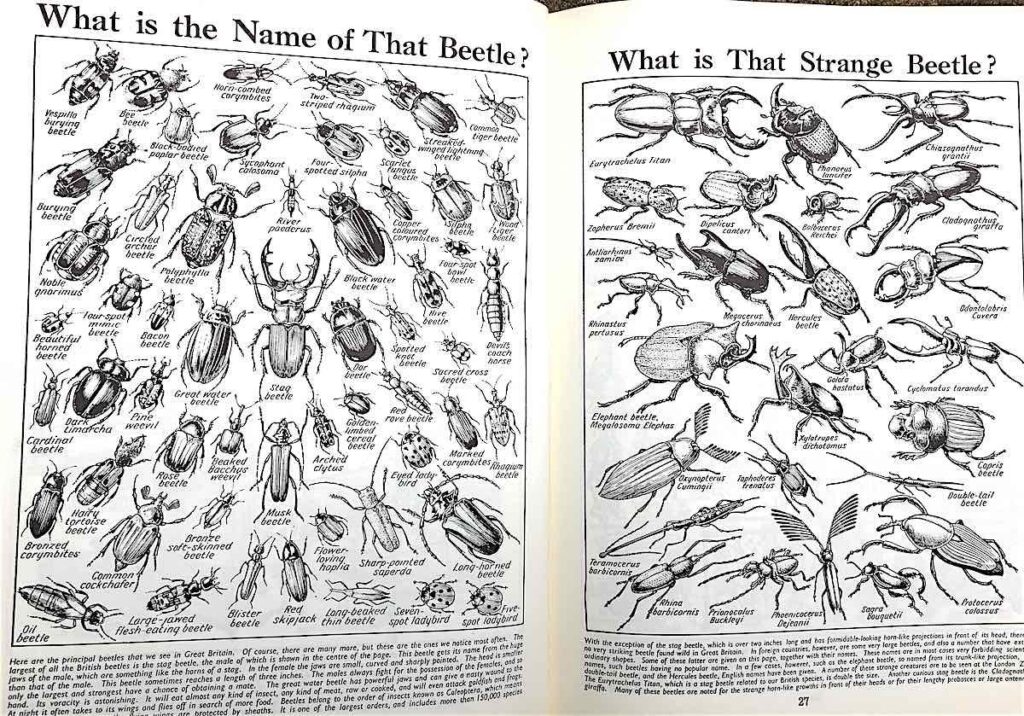
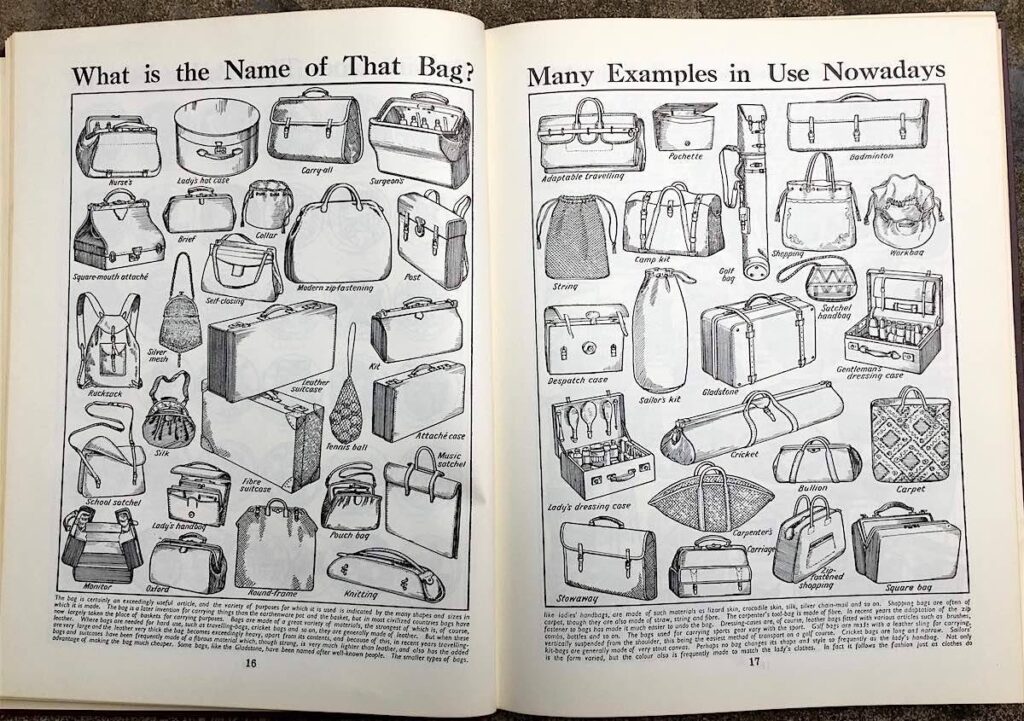
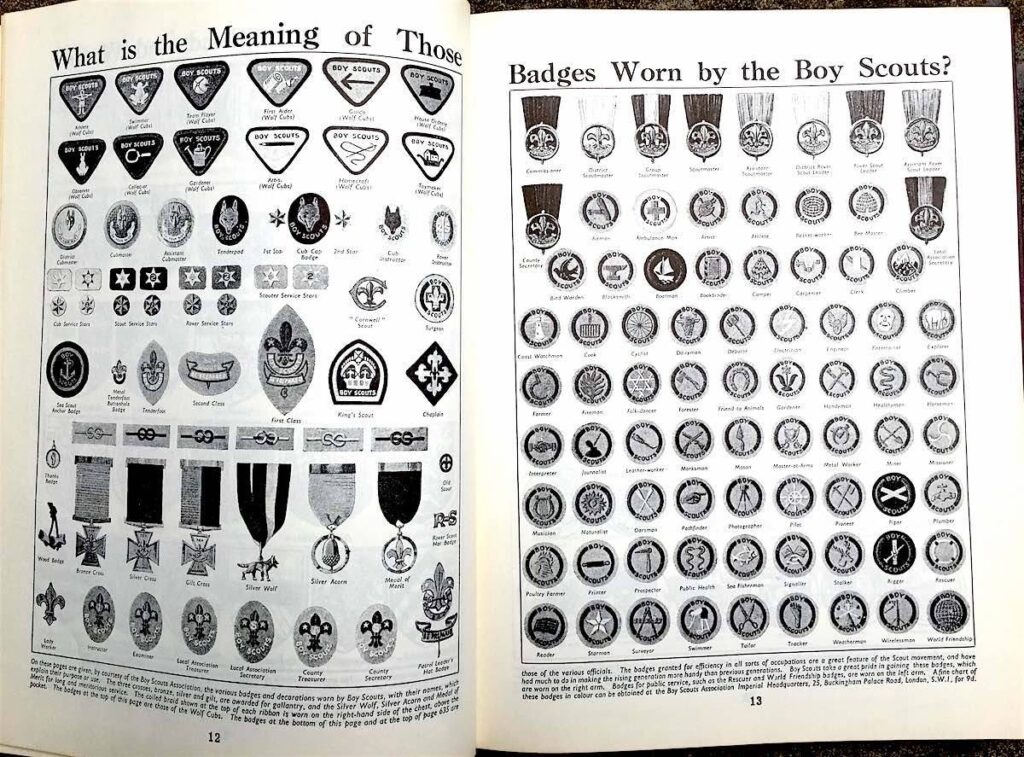
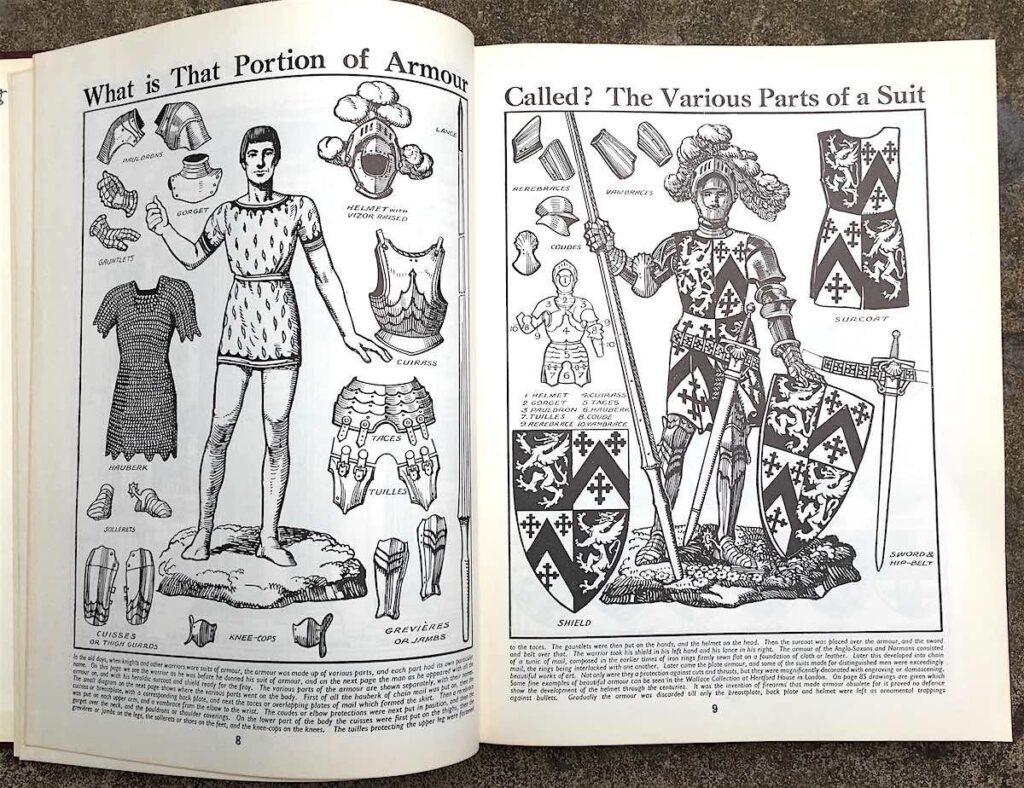
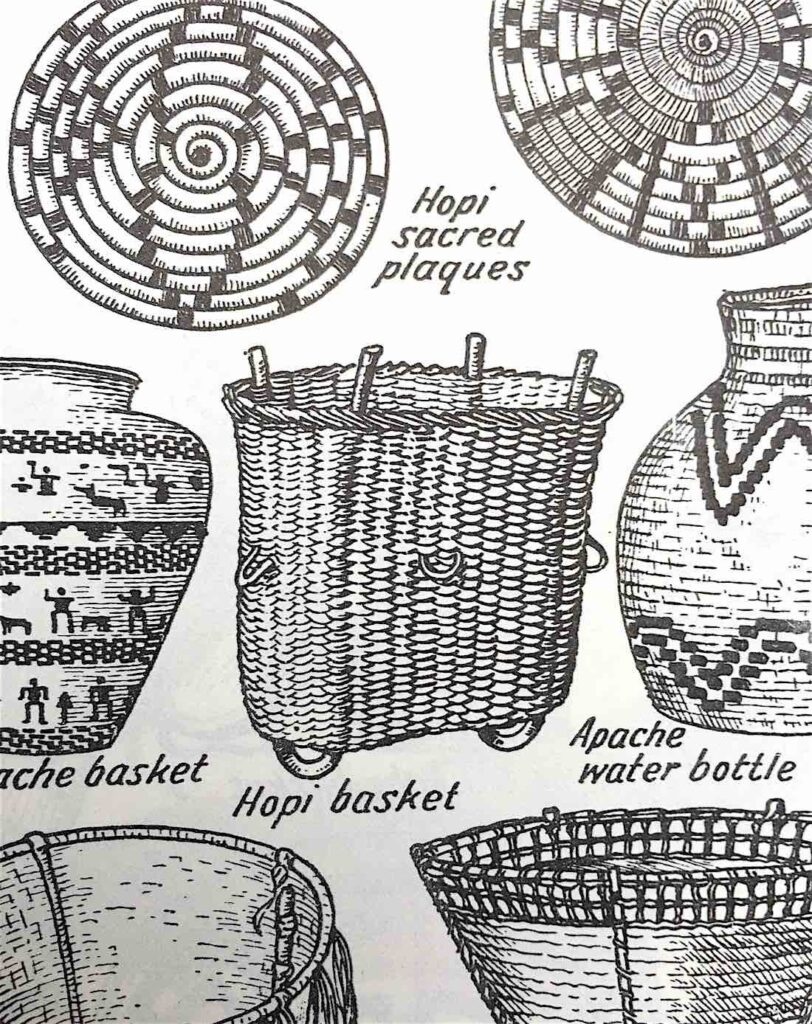
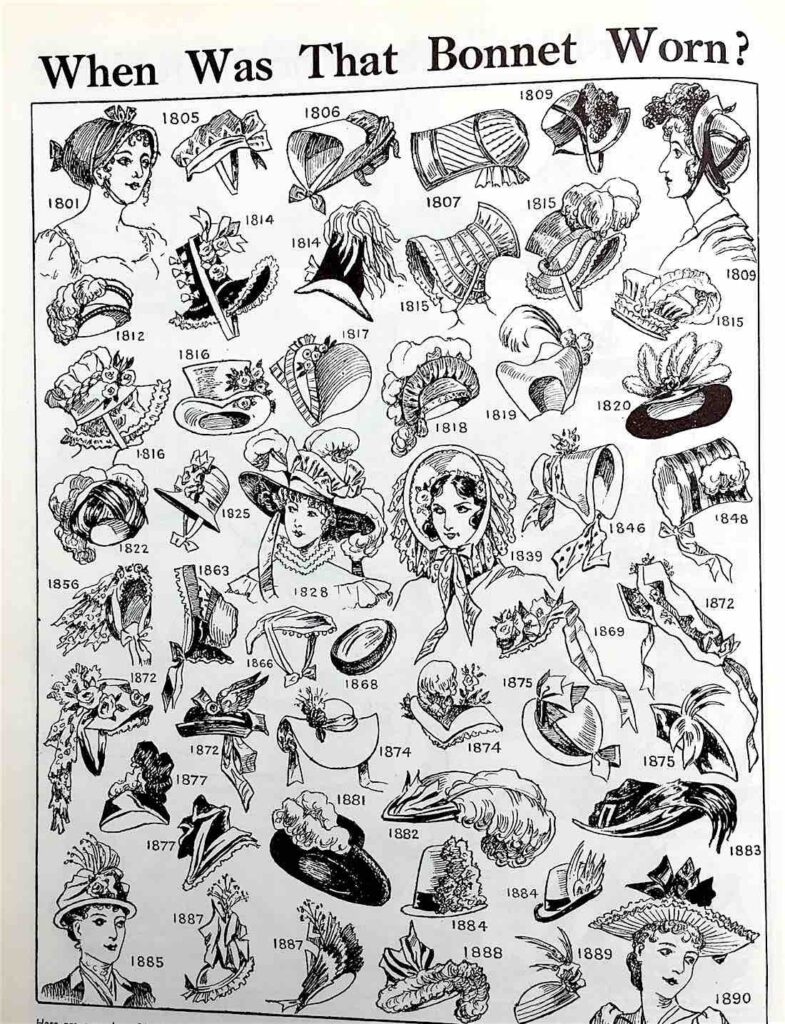
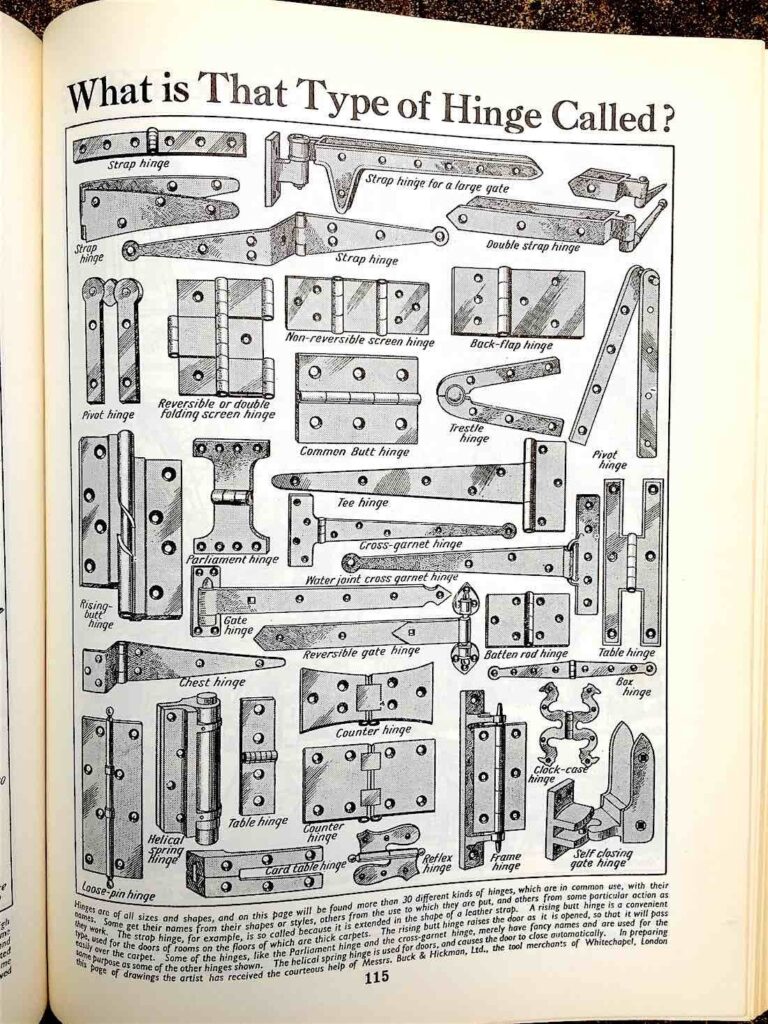
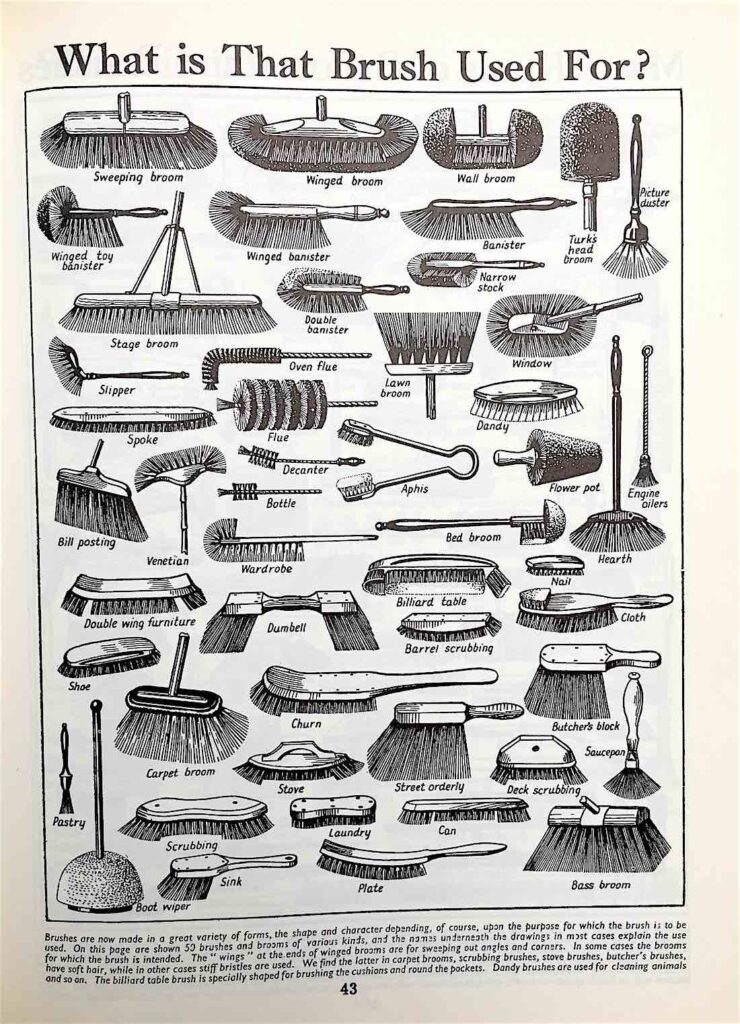
Mann’s Pictorial Dictionary and Cyclopedia Vol. 1
National Library Publications
1960, 240 pages, 8.5 x 11 inches
What are the different parts of a knife called? How about the parts of a plough? Does anyone know what kind of mousetrap this is? What do Eskimo ice scrapers look like? I’ve got this chrysalis here — what kind of butterfly or moth will emerge from it? Can anyone show me the difference between a bath tap and a double flexible tube cock? How about a White Persian versus a Manx? How did the piano evolve? What kind of ship is that sailing out of the harbor?
All of these questions and a ridiculously large number more are answered in Mann’s Pictoral Dictionary and Cyclopedia, 240 pages of the most miscellaneous miscellany out there. Each page poses a not-entirely-naturally-worded question at the top, then answers it with illustrations. If we believe the foreword of this 1960 edition, the original book was found in a bombed-out library in England shortly after WWII. One illustration shows a woman’s hairstyle from 1920, while another list, “To Which Country in the British Empire Does That Badge Belong?” includes Kenya and Gold Cost which, if I know my British history (note: I do not), suggests the book was published sometime between 1920-1957.
I’d owned this book for several years before I realized that the pages are not random, they’re alphabetical (as long as you can figure out what category the page has been classified under, which is not always clear). This leads to delightful transitions like going from cat’s cradle games, to cattle breeds, to oak chairs, or from “What Bible Fruit is That?” to “Examples of British Game Birds.”
The British dial is set to 11. “What is the Name of That Sedge? The Chief Species Growing in Britain” is a two-page spread on grasses. “What is the Meaning of Those Badges Worn by the Boy Scouts?” asks another page. “Which British Owl is That?” — it turns out that “Ten owls are found wild in England, and by means of these drawings it will be possible to identify any owl that may be seen.” Identify your raptors with confidence, Britain! It’s out of print, but used copies can be found at the link above. – Sara Lorimer
DEATH IS STUPID TALKS STRAIGHT TO KIDS ABOUT A TOPIC MOST GROWN-UPS STRUGGLE WITH
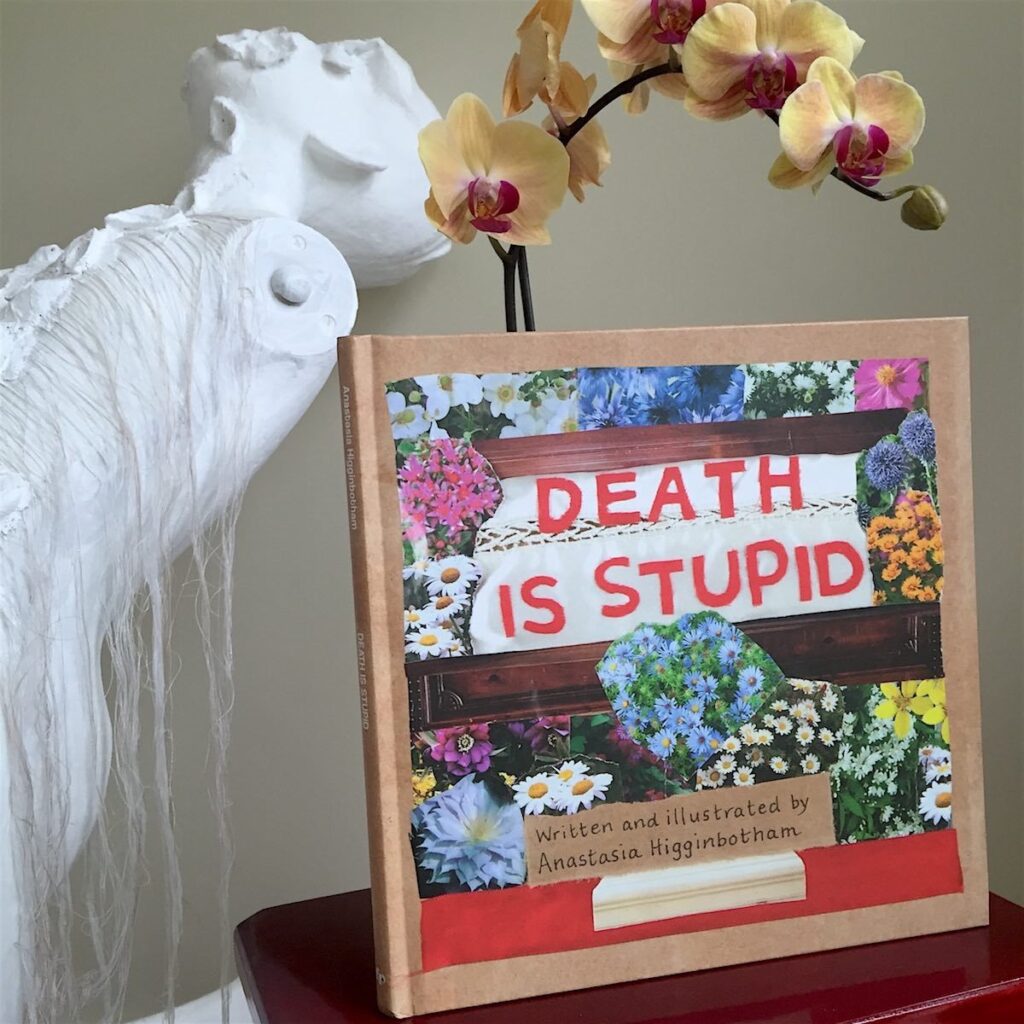
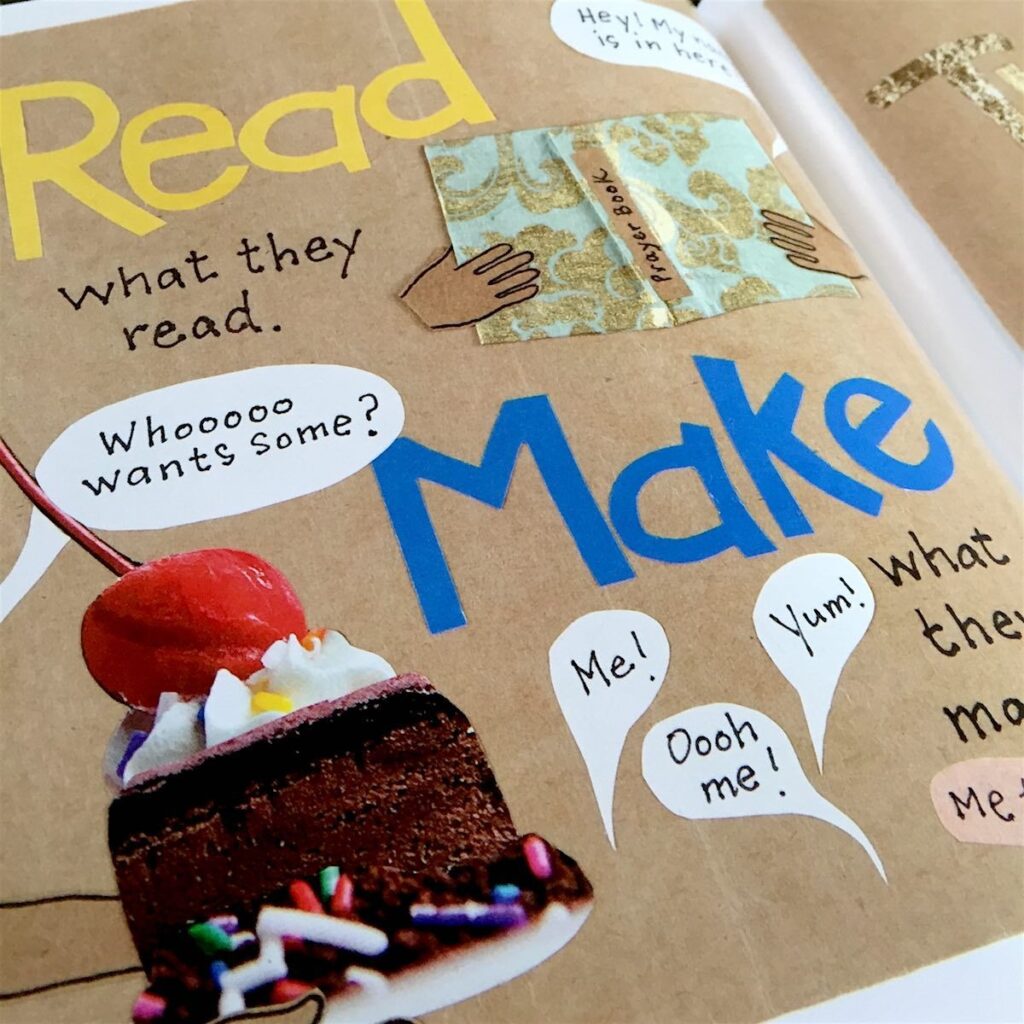
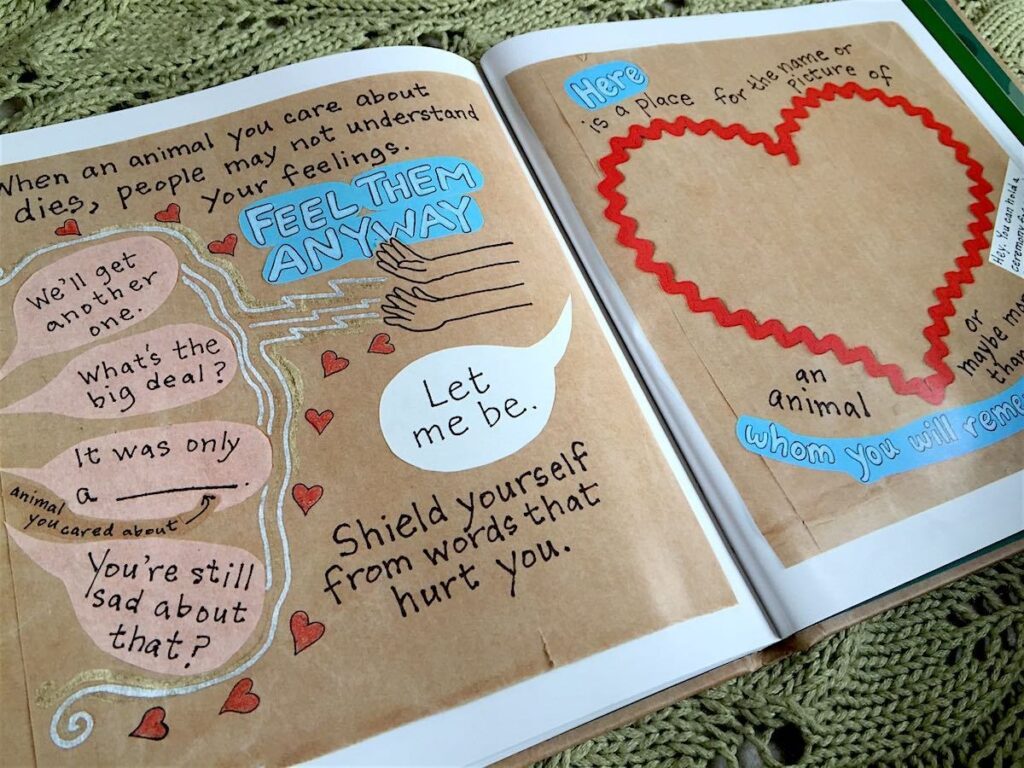






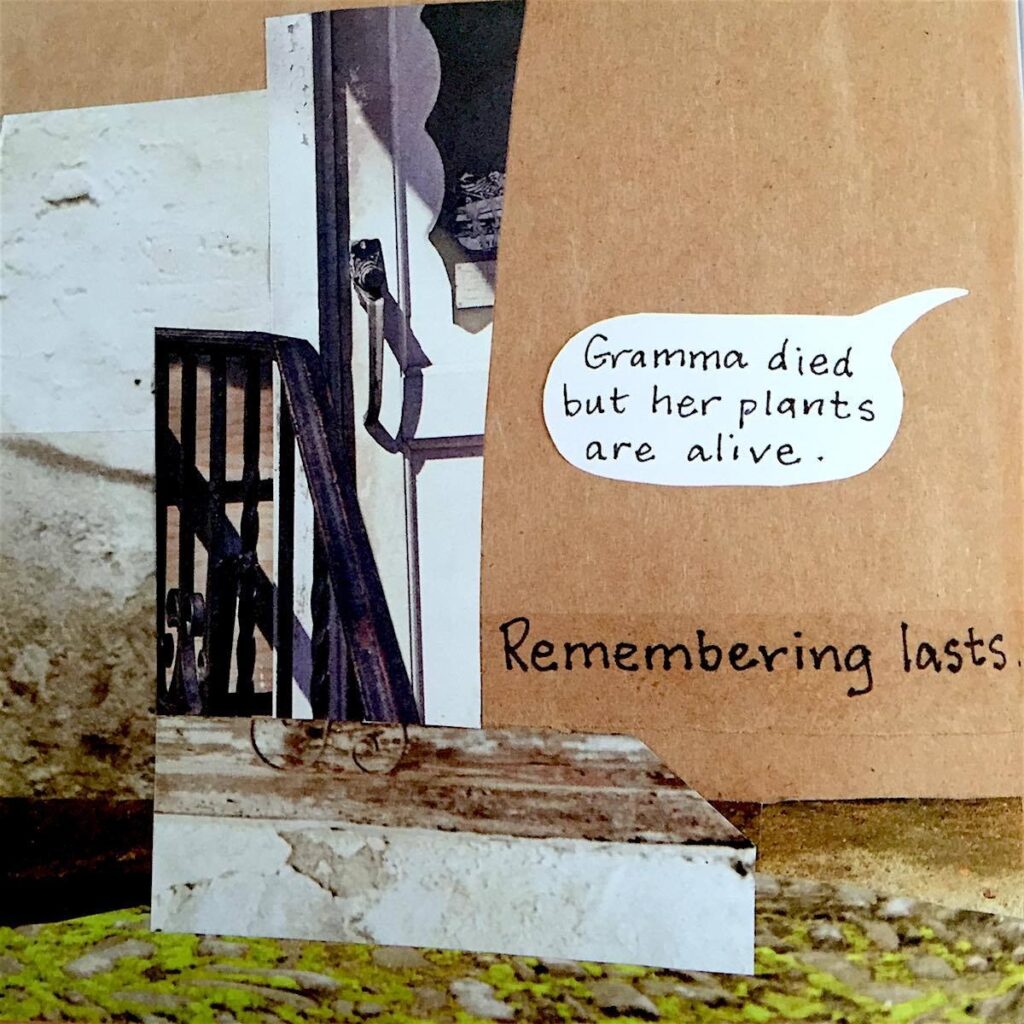
Death is Stupid
by Anastasia Higginbotham
The Feminist Press at CUNY
2016, 64 pages, 8.5 x 8.6 x 0.5 inches
Death is Stupid does what so many grown-ups struggle to do with their kids. It tells them the truth that they already know. In collages of illustrations and dialogue, Anastasia Higginbotham walks readers through the confusion and questions that come when someone dies. Using two concurrent narratives, one that broadly voices and validates the feelings and fears kids have around death, the other focusing on a little boy whose grandmother has died, Higginbotham masterfully draws connections for young audiences and their grown-ups.
The story opens, gracefully straight-forward, “When a loved one dies people can say some stupid things.” The line stretches over the course of three pages in which the boy goes from surprised to sad as he hears, “I know exactly how you feel.“ “Don’t cry.” “Just be grateful for the time you had with her.” We follow him through the funeral and days after, through the rituals of grief and remembrance, through the fumbling adult attempts to explain and comfort. Through his experience and the narrator’s staccato interjections (“Dying is not a punishment. But it mostly doesn’t feel fair.”), readers are given the space to explore the well-intentioned answers and advice that grown-ups pat into the palms and shoulders of the kids they love, and the ways in which those hugs and kisses can land like blows.
Just as the boy tries out different ways to stay connected to his grandma while accepting her death, like caring for her garden, readers can explore suggested activities at the back of the book. Higginbotham offers templates for personalized remembering of both pets and people, simple instructions (“Read what they read. Make what they made.”), and the loveliest reflection on the power of speaking someone’s name. I know that when we are inevitably grieving a loved one’s death, I will be grateful to have this book on hand to read with my daughter. – Mk Smith Despres
Books That Belong On Paper first appeared on the web as Wink Books and was edited by Carla Sinclair. Sign up here to get the issues a week early in your inbox.
12/30/2529 December 2025
Canning
Tools for Possibilities: issue no. 170

Best modern canning guide
New fashions in canning. Preserving is not really cheaper, nor is it a survival and disaster remedy. Canning these days makes sense as a culinary endeavor — because you can make preserves that taste better, or are far more varied than anything you can buy. This book is the best of a bunch of new guides on modern canning techniques and recipes (like Put ‘Em Up, which is decent but not as good). I prefer the recepies in Canning for standard items like james and jellies because it calls for far less sugar than other books, and it has a wide range of culinary influences. The book is also intelligently and simply designed with beautiful illustrations of the preserved treasures. — KK

- When I was growing up, canning was for old folks and cranks and separatists –oh, and for my parents, who spent every summer of my Virginia childhood scrambling to convert overflowing bushel baskets of fruits and vegetables from their garden into a pantry lined with shelf upon shelf of colorful canning jars, not to mention a stuffed-to-the-rim chest freezer or two. Not for me. I had better, far more important things to do. I can’t remember what they were.
For me, putting up the very best produce I can find in season–especially if it’s homegrown or from a nearby farm–is quite simply a way to spend some marginally productive time in the kitchen, preferably with my family and friends. Opening the jars and enjoying them later, I’m reminded of those fun times of tasting and talking, usually about food but also about music and politics and everything else that matters. In addition, taking on a kitchen project of a certain complexity, like canning or pickling or fermenting (or smoking meat or stuffing sausage or aging cheese), helps me remember what food was like when I was a kid and my mom and dad did these things, and what it might have been like when they were kids.
Low-sugar jams and preservesThe jams and fruit preserves in this book are all quite low in sugar, simply because I think looser, less-sweet spreads taste better than sticky, cloying ones. Most contain fresh lemon juice, which is added primarily for flavor but also to up the acid content a bit. The jams and preserves have a remarkably intense fruit flavor because excess water is cooked out rather than gelled with store-bought pectin.
Real picklesHere you’ll find everything from refrigerator pickles in vinegar brines that will last a few weeks or months in the fridge and don’t need any processing, to canned quickly brined pickles that will last a year in the pantry, to long-fermented pickles made sour by fermentation, to Indian and Middle Eastern-style “pickles” such as citrus preserved in salt. Most pickles are low in sugar, but not low in salt (which I fervently adore) or delicious tanginess, whether it’s that sharp bite of the acetic acid in vinegar or the mellow tang of fermentation-produced lactic acid. - So there you go. Heating to kill off existing microorganisms, processing to create a vacuum and prevent introduction and growth of microorganisms, and using high-acid foods or acidulating those that are not in order to create an acidic environment that’s inhospitable to microorganisms.
- Quick, High-Yield Strawberry Jam: Makes about 7 half-pint jarsHere’s a basic jam recipe that uses Pomona’s Universal, a commercial sugar-free low-methoxyl natural pectin derived from citrus rinds. It can be used in low- or even no-sugar recipes because it’s activated by calcium rather than sugar. You can adapt it to just about any fruit. If what you want is a lot of jam from not a lot of fruit (say, if you’re making a big batch to give as gifts), and if you want to cut back dramatically on the sugar content, this is the way to go. This jam, while not as intensely fruit-flavored as the no-commercial-pectin preserves in this book (here you’re essentially gelling the water that in other recipes is cooked off), will be thick, semi-firm, and light–a refreshing jam, if you will allow that such things exist. Pomona’s Universal can be found at health-food stores or online (see Sources, page 291).
- Strawberry Jam with Thai Herbs: Makes about 4 half-pint jarsThis is a sweet-tart preserve, but the mineral cilantro, fragrant thai basil, and fresh mint give it a complexity reminiscent of a good, well-balanced yum, or thai salad. Strawberries pair so well with herbs, and indeed all sorts of crazy savor things–balsamic vinegar with strawberries being one surprisingly long-lived trend–that it didn’t take much to come up with this extraordinary jam. Try this: Go out into the herb garden with a plate piled with halved berries and a little mound of sugar. (Or gather a bunch of leftover herbs from the refrigerator, or befriend a generous herb grower.) Dip a berry in the sugar, and pop it in your mouth with a few leaves of different herbs, tasting and tasting until you come up with a combination you like. It’ll be a little different from the actual jam, of course, but you’ll be able to tell if you’ll like the finished result.

The best pot under pressure
This is not your grandmother’s pressure cooker. Modern day versions are safe, easy to lock tight and are far quieter than units of yore. I can’t imagine my kitchen without one. The convenience plus time and energy savings associated with making things ranging from roasts to perfect risotto and even desserts is incredible. On top of that, everything inevitably turns out tastier and more nutritious than it would otherwise.
For the uninitiated, pressure cooking is a method of cooking in a sealed vessel that does not permit air or liquids to escape below a certain pressure. Pressure is created by boiling a liquid, such as water or broth, inside the closed pressure cooker causing the trapped steam to increase the internal pressure and temperature. This causes wet steam (or “saturated steam”) to be forced through the food and results in faster cooking times compared to conventional cooking methods. Once pressure is reached, the heat source can be dialed down significantly to maintain proper pressure for cooking. Pressure is slowly released through an external venting mechanism so that the vessel can be safely opened. A pot roast can be ready in 45-minutes, potatoes are cooked through in 10, broccoli and other vegetables barely take 5-minutes (at pressure) to become tender.
I’ve owned several brands and sizes over the years, but my favorite by far is the 6 qt. stockpot model made by Kuhn-Rikon of Switzerland. This unit, while not cheap, is extremely well-built, whisper silent and has multiple safely mechanisms built-in. Unlike the classic stream-release versions with the loud jiggly knob on top, this design retains most of the moisture, thus minimizing the amount of liquid required to get up and stay pressurized.
There are many less expensive, good quality pressure cooker alternatives out there that will serve you well, but I believe my Kuhn Rikon cooker will last for years of frequent use and look good doing it. — R. S. Parikh

Countertop flour mill
For 30-years we had an electric stoneground flour mill. It finally gave out and I got a steel-ground mill, and is it great. I realize that stoneground is the better way to go, but the new mill is so fast (20 times faster), and a joy to use.
We’re grinding most of our own flour for bread, etc. We grind organic California short-grain brown rice for cream-of-rice cereal. Easy to cook, delicious (a little butter, dark sugar, milk), and it’s a meal of freshly ground whole grains. I also use it to grind whole oats (called groats) into flour to make sourdough pancakes. No wheat. They’re delicious, and thanks to the sourdough, chewy. Fresh ground whole grains. Easy to do. — Lloyd Kahn
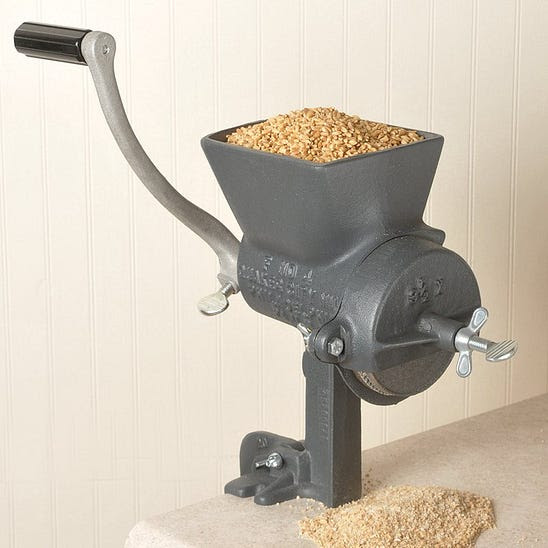
Grind your own oats
This elegant little Italian grain grinder has three hardened steel rollers that flatten grain for making flakes or crack it for making hot cereal or granola. I’d never had fresh oats before until my friend showed me this device, just after he gave me a breakfast bowl of fresh oatmeal along with flax seeds, shredded coconut, a little hemp oil for flavor, and brown sugar. As you grind oats you’re taking the whole oat grain (groat), and crushing and flaking it just before you cook it. You get nutty, delicious oatmeal, the flavor of the whole grain just released. Clamps to any surface up to 2″ thick. —Lloyd Kahn
12/29/2528 December 2025
Soulmates / Exhalation / Instant dice
Recomendo - issue #494
52 Surprising Things
Every December, writer Tom Whitwell publishes an eclectic list of 52 surprising things Whitwell learned over the year. It’s one of my favorite year-end reads. A few samples:
- Marchetti’s Constant is the idea that throughout human history, from cave dwellers to ancient Greeks to 21st century Londoners, people tend to commute for about an hour a day — 30 minutes out, 30 minutes home. So faster travel leads to longer distances, not less time. [Cesare Marchetti, plus a 2025 update]
- The Casio F91W — the ubiquitous digital watch, worn by Osama Bin Laden, costing just £12 — has been faked for years, and the fakes are getting better and better. [Andy C]
- Childhood peanut allergies are falling dramatically, perhaps because advice to avoid peanuts was reversed. [Simar Bajaj]
Browse his previous lists here. — MF
Watchable American history
I believe every American should be required to watch Ken Burn’s Civil War series to understand their country today. Ken Burns has done it again with his new series on The American Revolution. Six episodes, 12 hours. LIke his other series, it unsettles the story-book history we have in our heads, and celebrates the complexity of the actual ideas, events, and complicated characters at the time. — KK
See yourself as a verb
“The existential balm of seeing yourself as a verb, not a noun” is a perspective‑shifting essay that explores a gentler way to hold the fear of death by reframing the self not as something fixed, but as a natural unfolding process. The author suggests reframing personhood as a shifting weave of body, breath, memory, mood, and perceptions, always in motion and in relationship with the world. The idea is to loosen perfectionistic pressure around having to be a fixed, definitive “someone,” and instead approach death as a quieting down of processes rather than the annihilation of a solid self. — CD
Sharpen dull Airbnb knives
I’ve stayed in Airbnbs in many different countries, and have learned one universal truth: the kitchen knives are invariably dull. As a service to myself and future guests, I’ve started bringing a small knife sharpener with me when I travel. The Smith’s 2-Step Knife Sharpener is inexpensive, small, and lightweight, so I don’t mind packing it. It takes less than a minute to restore the edge on a blade. — MF
Freak Pages
Freak Pages is a directory for the weirdest Wikipedia entries, community‑curated to help you discover strange topics you’ve probably never heard of. Lots of rabbit holes to dive into. — CD
Quotable quotes
Here are some quotes I gathered recently:
- It takes a lot of work to make something simple. — Steve Wozniak
- One of the most realistic parts of Lord of the Rings is that almost no one wanted to get involved, until it was very nearly too late. — Ricki Tarr
- Everyone searches for opportunities while running from problems, missing that they’re the same thing. Problems aren’t obstacles to opportunity, they ARE the opportunity. — Shane Parrish
- Without data, you’re just another person with an opinion. — W. Edwards Deming
- When people ask me if I went to film school I tell them “No I went to films.” — Quentin Tarantino
- Thinking small is a self-fulfilling prophecy. — Jeff Bezos
- The three lenses of opportunity cost: (1) Compared with what? (2) And then what? (3) At the expense of what? — Shane Parish
- You never know what worse luck your bad luck has saved you from. — Cormac McCarthy
- Everyone driving slower than you is an idiot, and everyone driving faster than you is a maniac! — George Carlin
I find witty quotes sharpen my thinking and help me pay attention. — KK
Sign up here to get Recomendo a week early in your inbox.
12/28/2525 December 2025
Expiring Perks/Bone-conducting Earbuds/Forge Travel Wallet
Nomadico issue #185
Check for Year-end Credit Card Perks
While some travel credit card perks renew whenever your annual fee comes due, such as United card lounge passes or the IHG card’s free night’s stay, others are on a calendar year. I just saved $150 on 2026 hotel stays by tapping a $50 credit on the Chase Sapphire Preferred card and a $100 one on my Delta Amex one that would have expired 12/31. Keep this in mind when applying for a new card too: if you obtain it with enough time on the calendar, you could benefit twice in less than a year.
Earbuds That Don’t Go in Your Ear
My wife has tinnitus that probably dates back to our music biz days in New York and earbuds that go into your ears make it worse for many people with that condition. Headphones are usually better but are bulky. She recently found a solution in Shokz earbuds that sit outside the ear and conduct sound through the bones of your skull. These don’t block noise, which could be a downside on a plane, but that’s a plus for runners and bicyclists who want to stay aware of their surroundings. Here are links to the two-piece over-ear ones that go in a recharge case and the single unit that fits over the head like normal headphones.
England’s Expensive Airport Drop-offs
“Can you take me to the airport?” might be a question that requires you to pull out your wallet if you’re in England. I had no idea airport drop-off fees were even a thing until I saw this story about them increasing to £10 ($13.40) at the London Gatwick airport. Apparently you also have to pay £7 to drop someone off at Heathrow. This hikes up the price of any taxi or Uber charge as well. Apparently they really want you to #takethetrain.
A Different Kind of Travel Wallet
I usually use a bulkier wallet at home than I do when I travel and I like this new Forge Wallet I’ve been using lately. It’s about the thickness of a normal wallet but much narrower, with a compartment where you press down on a button and your credit cards pop out, staggered so you can see which one is which. It’s RFID blocking and there’s an optional little steel multi-tool card that fits inside a dedicated pocket. See my quickie Instagram reel on it here.
A weekly newsletter with four quick bites, edited by Tim Leffel, author of A Better Life for Half the Price and The World’s Cheapest Destinations. See past editions here, where your like-minded friends can subscribe and join you.
12/25/25ALL REVIEWS
 12/21/25
12/21/25
52 Surprising Things / Watchable American history / See yourself as a verb
Recomendo – issue #493
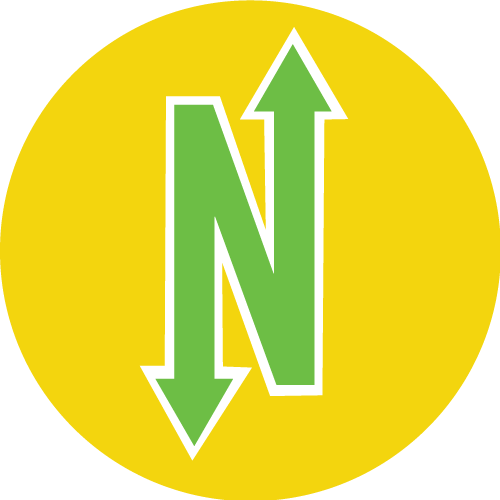 12/18/25
12/18/25
Functional Traveler Gifts/Tougher Italian Passport/Cheaper Streaming Options
Nomadico issue #184
EDITOR'S FAVORITES
COOL TOOLS SHOW PODCAST
WHAT'S IN MY BAG?
17 December 2025
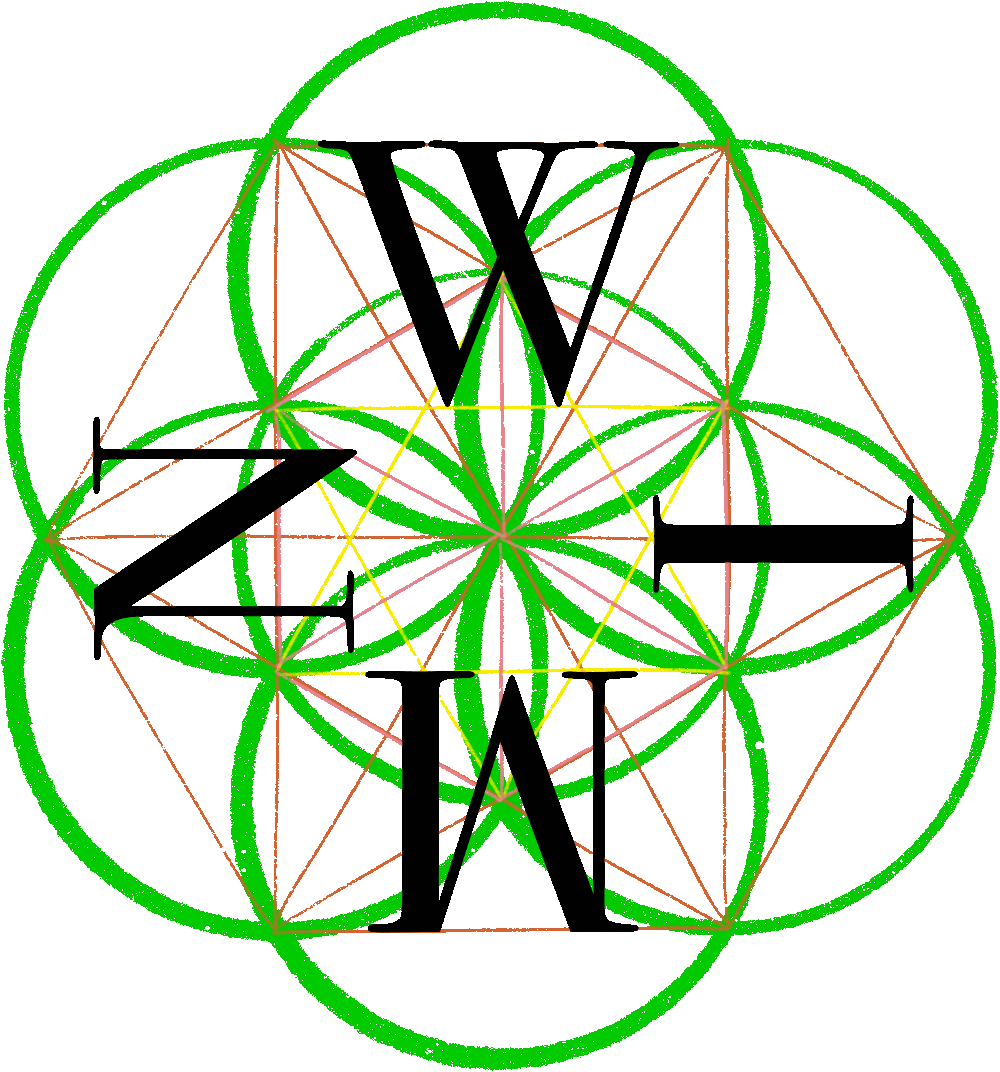
ABOUT COOL TOOLS
Cool Tools is a web site which recommends the best/cheapest tools available. Tools are defined broadly as anything that can be useful. This includes hand tools, machines, books, software, gadgets, websites, maps, and even ideas. All reviews are positive raves written by real users. We don’t bother with negative reviews because our intent is to only offer the best.
One new tool is posted each weekday. Cool Tools does NOT sell anything. The site provides prices and convenient sources for readers to purchase items.
When Amazon.com is listed as a source (which it often is because of its prices and convenience) Cool Tools receives a fractional fee from Amazon if items are purchased at Amazon on that visit. Cool Tools also earns revenue from Google ads, although we have no foreknowledge nor much control of which ads will appear.
We recently posted a short history of Cool Tools which included current stats as of April 2008. This explains both the genesis of this site, and the tools we use to operate it.

